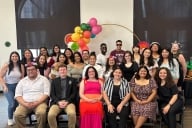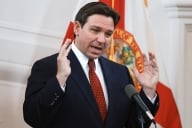You have /5 articles left.
Sign up for a free account or log in.
NEW YORK -- “The conduct of individual policemen received much adverse criticism from the Negroes. This was to be expected in the circumstances, but disregarding the general prejudices of which white officers were accused, certain cases of discrimination, abuse, brutality, indifference and neglect on the part of individuals are deserving of examination.”
Dated racial language aside, if the above paragraph – ripped from a 1922 commission’s report on the Chicago Race Riot three years earlier – sounds eerily familiar, it should. That’s what a panel of historians said here Monday during a session called “Understanding Ferguson: Race, Power, Protest and the Past” at the annual meeting of the American Historical Association. (There are other parallels: As recent anti-police protests in Ferguson, Mo., New York and elsewhere stemmed from the deaths of unarmed black men and women at the hands of police officers, the 1919 Chicago riot began after a young black man waded into an unofficially segregated beach and drowned after being hit with rocks by white bathers; a white police officer was alleged to have refused to arrest someone for the crime.)
“Ferguson brings us here but it’s a metaphor for a long, ongoing history” of discriminatory police practices, said Khalil G. Muhammad, director of the Schomburg Center for Research in Black Culture, who chaired the panel. Despite the “keen and prophetic” recommendations about policing and race included in 1922’s “Negro in Chicago” report and others like it since, he said, a lack of political will has left them “gathering dust” while other, insidious narratives about the black community and crime dominate.
So although historians may be more comfortable working with the past than commenting on contemporary events, speakers said, they’ve got an obligation to help students and society at large understand the context from which the recent protests emerged.
Historians also need to rail against the deleterious “myth” of post-racialism to help promote progress, speakers said.
William Jelani Cobb, associate professor of history and director of the Institute for African American Studies at the University of Connecticut, visited Ferguson four times to report on the protests over the police shooting death of an unarmed man named Michael Brown for The New Yorker, where he is a contributing writer. He said it seemed that the syllabus for his 20-century African-American history class had “jumped off the page” there, and that many of the dynamics he teaches about seemed to “converge on the ground.”
Black residents in particular tended to speak less about Brown’s death than the “context in which it occurred,” Cobb said, noting that interviewees invoked the 1857 U.S. Supreme Court case involving Dred Scott, a Missouri slave who unsuccessfully sued for his freedom. They asked elected officials who came to Ferguson why local schools were closing, or about housing projects and urban blight. Colin Gordon, professor of history and director of undergraduate studies at the University of Iowa, who studies public policy and political economy, offered additional context for Ferguson, saying that the area is physically, politically and financially segregated in ways that are similar to but more exaggerated than other semi-urban, minority neighborhoods.
It all amounted to a strange sense of history repeating itself, Cobb said – hence the name of one his New Yorker dispatches: “Chronicle of a Riot Foretold,” borrowed from the Gabriel Garcia Marquez novella called Chronicle of a Death Foretold, in which a man’s death is predicted but not prevented. Everything that happened during the riot was an “object lesson” in what had brought protesters into the streets in the first place, he added.
Muhammad said recent comments by Rudy Giuliani, former mayor of New York, that “white police officers wouldn’t be there if [blacks] weren’t killing each other 70-75 percent of the time” exemplify racial narratives that must be dispensed with, if progress is finally to be made.
Heather Ann Thompson, an associate professor of history and African-American studies at Temple University, said the backlash against those who have spoken out against alleged police brutality – herself included -- is proof that racism is “not only not dead but more virulent than ever.” (Other panelists said they’d also received hate emails and messages for writing publicly about Ferguson.)
Thompson, a scholar of the civil rights movement, said society has come “full circle,” in that some of the gains achieved since the 1960s have withered. Despite setbacks, however, she said, Ferguson presents an “opportunity to really reckon with the damage done by the myth of post-racialism,” which has made “racism so much easier to spout, espouse and wrap our heads around than it has been in decades.”
It’s also time for historians to definitively link the “weird” gap between public dialogues about the exploding prison population and its “feeder”: overcriminalization, particularly of black men, she said.
But just how should scholars (particularly those whose disciplines may not naturally lend themselves to such conversations) broach those topics, both with students and members of the general public – some of whom may be resistant to such discussions? That’s what several audience members asked.
Marcia Chatelain, an assistant professor of history at Georgetown University who created the collaborative Twitter project for teachers of history called #FergusonSyllabus, said there were multiple ways for non-scholars of American history to get involved. She said architects, for example, could talk with students about how space or urban planning plays a role in structural racism. Chemists, she said, could open up a conversation by talking about tear gas. No one asked about when it might not be appropriate to talk about such issues in college classes, and that topic was not discussed by panelists.
Chatelain discussed the concept of a “shadow syllabus,” saying there’s sometimes a difference between what a professor says he or she is talking about and the underlying lesson.
Thompson said many of her students’ first impulse upon hearing about the Ferguson protests was to “get on a bus” and go there. But she said she encouraged her students to get involved in activism on their own campus and in their own communities. Chatelain, who attended the University of Missouri at Columbia as an undergraduate, said she also encouraged students to get involved in local community activism, and not only during crises. She said she once advised a white student who asked about ways to support communities of color about not just “showing up” when bad things happen.
“Where were you when we were laughing, or happy?” she recalled asking rhetorically.
Chatelain advocated feminist principles of teaching, in which “we talk, we are a community together. We’re always talking about something.” Ultimately, she said, discussions about Ferguson shouldn’t be divisive, as some have suggested in conversations about #FergusonSyllabus, for which a domain name was recently purchased.
“This is not about creating a contentious, upsetting, horrible thing, but modeling for students … what citizens can do in the world,” she said. “I can’t wait to hear the conversations we’re going to have.”









